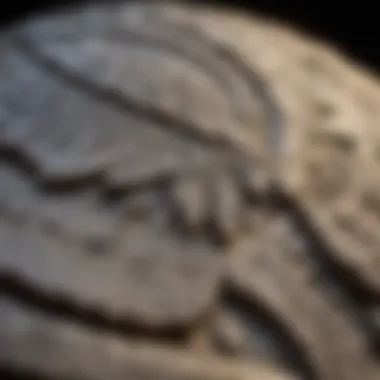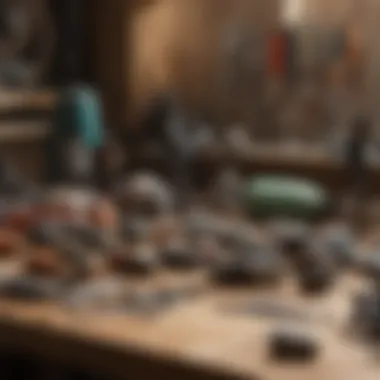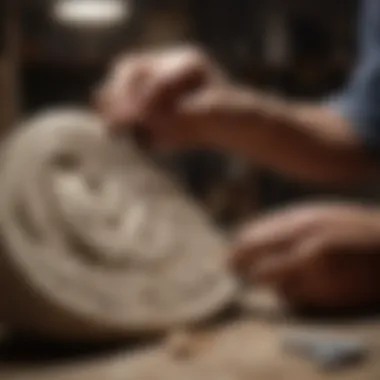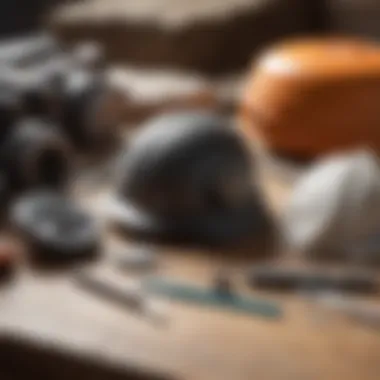Mastering Stone Carving Techniques with Rotary Tools


Intro
Stone carving, an ancient craft steeped in history, has transitioned from rudimentary techniques to the sophisticated use of rotary tools. This evolution not only enhanced the craftsmanship but also broadened the creative possibilities for artists and hobbyists alike. Understanding the intricacies of this craft is essential for anyone looking to create with precision or delve into the world of geological wonders.
History and Origins
Overview of Collectibles, Rocks, and Fossils
Stone carving dates back thousands of years, tracing its roots to early humans who sought both practical and artistic outlets. The materials chosen often reflect the surrounding geology—local rocks ranging from soft alabaster to hard granite became the canvas for countless artisans. Collecting rocks and fossils is not just a pastime but a window into the past, connecting enthusiasts with the Earth’s geological formations. Each piece tells a story, whether it’s a fossilized fern or a striking piece of quartz.
Historical Significance and Cultural Impact
Throughout history, different cultures have demonstrated unique relationships with stone. In Ancient Egypt, artisans produced intricate carvings to honor their deities, while Native American tribes utilized stones to create tools and ceremonial artifacts. As stone carving developed, it contributed significantly to cultural expression and identity. Fast forward to today, the craft continues to inspire, with rotary tools allowing for precision work that was once unimaginable. This progression certainly speaks to the adaptability of human creativity in response to evolving technologies.
Identification and Classification
Guide to Identifying Rocks and Fossils
Recognition of raw materials is a crucial skill for any stone carver. Familiarity with common rocks—such as limestone, sandstone, and marble—will come in handy when choosing the right stone for projects. Fossils, on the other hand, provide insight into the Earth’s biological past and add a unique touch to artistic pieces. Knowing the distinctions between various types can elevate the quality of work.
Common Types and Variations
- Limestone: Soft and easy to carve, great for intricate designs.
- Granite: Hard and durable, suitable for lasting monuments.
- Soapstone: A favorite for beginners; it's gentle on tools and hands.
- Basalt: Often used for large sculptures due to its toughness.
"Each stone has its own character, and finding the right piece can feel like a treasure hunt encompassing history and artistry."
In addition, fossils come in various forms, each carrying environmental histories that can supplement a carver’s work. The interplay of stone and fossilization allows for a unique blend of natural beauty and human craftsmanship, making every carved piece a testament to both skill and nature.
Through meticulous practice and appreciation for both the tools and materials at hand, stone carvers can breathe life into static forms, bridging past narratives with contemporary artistry. As technology continues to advance, the potential for innovation in stone carving through rotary tools remains vast, enticing learners and masters alike to embark on their creative journeys.
Prelims to Stone Carving
Stone carving has a rich tapestry that weaves together art, culture, and history. This ancient craft not only serves to create stunning visuals but also possesses deep narratives embedded in each chisel mark. Whether you’re a rock collector or just stepping into the realm of stone artistry, understanding this topic provides the groundwork for engaging with a practice that has captivated humanity for millennia.
Historical Background
The roots of stone carving can be traced back thousands of years, with evidence found in ancient civilizations spanning from the Egyptians to the Greeks. The Pyramids of Giza, for instance, showcase incredible feats of engineering and artistry. The blocks of limestone were meticulously carved and placed by skilled artisans, demonstrating not just the use of simple tools but a sophisticated understanding of materials—certainly not something you’d whip up in a weekend workshop.
In China, the Great Wall and intricate Buddhist carvings offer a glimpse into the labor and artistry that stone carving involved. Early societies relied on stone for tools, weapons, and monuments, leading to developments in carving techniques over time. The Renaissance brought about a revival in sculpting, where artists like Michelangelo elevated stone into a canvas of expression, breathing life into marble with nothing but their tools. Scholars believe that the methods used in those times laid the groundwork for contemporary stone carving techniques, blending tradition with innovation.
Cultural Significance
Stone carving isn’t merely about the final piece; it’s an expression of culture, identity, and belief. Different cultures adopted distinct styles and themes, imbuing their work with layers of meaning. Indigenous peoples often carved totem poles that told stories and marked significant events or lineages. These were not just decorative but carriers of history and values.
In modern times, stone sculptures continue to grace public parks and museums worldwide, provoking thought and appreciation for both art and culture. Whether it’s a monumental statue honoring historical figures or functional sculptures in urban settings, stone carving remains relevant today, urging us to consider our place in history and society.
"Art is not freedom from discipline, but disciplined freedom." - John F. Kennedy
As we explore stone carving with rotary tools, it’s crucial to recognize the legacy this craft carries forward. This understanding opens doors to both the emotional connection one can have with the materials and the technical prowess required to manipulate them thoughtfully.
Understanding Rotary Tools
When it comes to stone carving, rotary tools are like the Swiss army knives of the craft. They bring a unique versatility that can significantly elevate the quality of a piece, allowing for both detailed work and broader shaping. In this segment, we will dissect the essence of rotary tools, detailing their construction, function, and why they are indispensable in the stone carving process.
What is a Rotary Tool?
A rotary tool is a handheld power device equipped with a variety of bits and attachments that can perform different tasks. Its design comprises an electric motor that spins a drive shaft at high speeds, allowing users to carve, sand, polish, drill, or even engrave on various materials, including stones. Think of it as a small powerhouse that fits in the palm of your hand. This enables unparalleled control over intricate designs while maintaining the ability to tackle larger tasks with ease. Whether a hobbyist or a seasoned artisan, understanding how rotary tools work is crucial for successful stone carving.
Types of Rotary Tools
Choosing the right rotary tool can feel like finding a needle in a haystack, given the various options available. Let's break it down into manageable parts.
Corded vs. Cordless
When deciding between corded and cordless rotary tools, several factors come into play. Corded tools draw consistent power from an electrical outlet, offering high torque and prolonged usage without the worry of battery life. This makes them a solid choice for heavy-duty tasks, especially when dealing with hard stone like granite. However, they can limit mobility as you are tethered to a power source.
On the flip side, cordless rotary tools provide fantastic flexibility and ease of movement, perfect for detailed work on carving projects where accessing tight spaces is essential. They usually feature lithium-ion batteries, allowing for quick recharging.
"Every stone holds a story. The right tool might just help you uncover it."
Each type has its advantages and disadvantages; your choice will largely depend on the nature and scale of your projects.
Variable Speed Options
One of the standout features of rotary tools is their variable speed options. This allows the user to adjust the rotation speed according to the material's toughness and the task's intricacy. Slower speeds can be advantageous for delicate work, like fine detailing, while faster speeds can help in rough shaping or sanding.


This adaptability is highly beneficial because it prevents stone from overheating and reduces the risk of chipping or cracking, which can be particularly distressing with softer materials like alabaster.
Specialized Models
As stone carving has evolved, so have the rotary tools designed for it. Specialized models cater to specific needs; some are designed for engraving while others excel in sculpting. These tools often incorporate unique features such as enhanced ergonomics for comfort during long sessions and improved cooling systems to handle heat generated by extensive use.
The right specialized tool can make all the difference when trying to achieve complex designs or unique textures. However, they might come with a heftier price tag, so weighing the cost against your expected use is important.
Understanding these various rotary tool options is the first step toward honing your skills as a stone carver. The next sections will elaborately discuss essential attachments and techniques that can transform simple stones into mesmerizing works of art.
Essential Attachments for Stone Carving
When engaging in stone carving, the tools and attachments one chooses can make or break the quality of the work. The right attachments enhance precision, creativity, and efficiency, turning a block of stone into a magnificent piece of art. Let's delve into the key types of attachments essential for this craft, focusing on how each contributes to successful stonework.
Carving Bits
Carving bits are the heart and soul of stone carving, providing the means to shape and detail the material. Three popular types stand out: diamond bits, carbide bits, and high-speed steel bits. Each of these serves distinct purposes and offers unique benefits.
Diamond Bits
Diamond bits are a top-tier choice for any stone carving enthusiast. Their key characteristic lies in their durability and precision; they can tackle the hardest stones like granite and quartz without breaking a sweat. The embedded diamond particles create a smooth finish, which is invaluable for intricate designs.
Because they are so effective, many professionals consider diamond bits a must-have in their toolkit. However, working with diamond bits can come at a cost—they are typically more expensive than alternatives. Moreover, while they offer excellent longevity, they require careful handling during use to prevent unnecessary wear.
"Utilizing diamond bits is akin to wielding a magic wand in the world of stone carving; you can literally transform stone with ease."
Carbide Bits
Carbide bits hold their ground as a popular choice for versatility and overall value. These bits can efficiently carve both softer stones, like soapstone or alabaster, and tougher ones. Their sharp edges allow for both heavy removal and finer detailing, making them a favorite among hobbyists and professionals alike.
One unique feature of carbide bits is their ability to withstand high temperatures generated during carving. This characteristic prevents tip dulling that often plagues other types of bits. However, users need to be cautious as carbide bits can chip if used improperly on harder stones. Overall, they are a reliable, cost-effective option, providing an excellent balance between durability and affordability.
High-Speed Steel Bits
High-speed steel bits serve as the workhorse of the stone carving world. Known for their strength, they are particularly effective when working with softer stone types. The key characteristic of these bits is their ability to maintain a sharp edge while providing a rapid cutting action, making them ideal for extensive projects.
One might find high-speed steel bits to be beneficial due to their affordability and accessibility. For beginners, they can be an entry point into the craft of stone carving, allowing for experimentation without breaking the bank. However, they require frequent sharpening when tackling tougher materials, which can be a drawback in terms of time.
Polishing Tools
As important as carving bits are, polishing tools should not be overlooked. Once the main sculpting is completed, polishing tools come into play to deliver that desired finish. They help smoothen out rough edges, revealing the stone’s natural luster and beauty. Various options are available including polishing pads, felt wheels, and even specialized compounds that work wonders on stone surfaces.
Cutting Discs
Cutting discs are another essential tool for stone carving, particularly for shaping the material before the detailed work begins. These discs can handle the slicing of large blocks of stone down to manageable sizes or even creating intricate cuts. They come in various sizes and types, each suited for specific tasks, from basic cuts to more elaborate profiles. The quality of cutting discs can determine the efficiency and effectiveness of your initial cuts, greatly influencing the overall workflow in a stone carving project.
Techniques for Effective Stone Carving
With the mastery of stone carving comes a need to understand and implement effective techniques. These methods are essential not only for achieving aesthetic results but also for ensuring safety and efficiency in the craft. Techniques can influence the final appearance of a piece, making it crucial for both beginner and experienced carvers to grasp these foundational elements. This section outlines basic and advanced techniques that provide both artistry and precision in stone carving.
Choosing the Right Stone
Picking the right stone is paramount in the world of stone carving. It can determine not only the ease of your work but also the quality and appearance of the finished piece. Each type of stone comes with its own unique characteristics and challenges. Understanding these nuances is vital for both novice and seasoned carvers alike.
The choice of stone impacts everything from the initial carving technique to the final polishing touch. It affects not just the tool selection, but also how details can be executed and how effectively the stone holds its form. A poor stone choice can lead to frustration and unsatisfactory results, while a well-suited stone can open doors to creative expression and satisfaction in craftsmanship.
Types of Stones Suitable for Carving
Soapstone
Soapstone is very popular among carvers due to its soft, fibrous nature. It’s easy to carve, making it a perfect medium, especially for beginners. The key characteristic of soapstone is its talc content, which gives it a smooth feel and makes it pliable. This softness allows tools to easily shape the stone without requiring excessive force. Its unique feature is its ability to retain heat, which can be favorable when polishing. However, it's crucial to know that while it’s great for intricate designs, its softness also makes it less durable than harder stones. Carvings can be more susceptible to damage or wear over time.
Alabaster
Alabaster is lauded for its exquisite translucence and the range of color it offers. This stone gives an appealing aesthetic effect when carved, making it ideal for decorative pieces. The highlight of alabaster is its fine grain, which allows for detailed carving without the hassle of breaking. It’s particularly beneficial for those looking to create small, intricate works of art. However, alabaster, while generally easy to work with, does have a tendency to be brittle, meaning that extra care is needed during the carving process to avoid cracks or chips.
Marble
Marble stands as a classic choice in stone carving, its legendary status rooted in both beauty and durability. The hallmark of marble is its variety of colors and patterns, which can add a stunning visual dimension to sculptures. It’s sought after because it allows for intricate details and a smooth finish when polished. The unique feature of marble is its strength; it can withstand the test of time, which is particularly advantageous for larger sculptures or outdoor pieces. However, the very hardness that contributes to its durability can also make it more challenging to carve, requiring sharper tools and more skill.
Assessing Stone Quality
When selecting stones for carving, assessing quality is crucial. Not all stones are created equal; some may harbor cracks or inconsistent grain patterns that could complicate your project. Here are a few key aspects to consider:
- Soundness: A simple tap test can help gauge whether the stone has internal fractures. A clear sound often indicates good quality.
- Grain Patterns: Uniformity in grain is essential, as irregular patterns can affect how tools interact with the stone and result in detailed challenges down the line.
- Texture: Smoothness and consistency in texture will lead to a more favorable carving experience. Stones with rough spots can be troublesome, delaying progress in detail work.
In summary, choosing the right stone means taking into account its properties, advantages, and potential drawbacks. Whether opting for soapstone, alabaster, or marble, a mindful selection will enhance both the carving experience and the final art piece.


Safety Practices in Stone Carving
When venturing into stone carving, safety practices cannot take a backseat; they must be front and center. Engaging with rotary tools creates a delightful blend of creativity and risk, which is why understanding safety protocols is crucial for any enthusiast. Not only can the right safety measures help prevent personal injury, but they can also ensure that your workspace remains conducive to productive work. Emphasizing precautions helps forge a rewarding experience and can keep the frustrations of accidents at bay.
Protective Gear
Protective gear forms the first line of defense against the myriad of hazards present in a stone carving workshop. Each piece of equipment serves a specific purpose, and investing in quality items can significantly reduce risks.
Safety Glasses
Safety glasses are indispensable to any stone carver. They protect your eyes from flying debris that can arise when chiseling away at a rock. One key characteristic is their durable lenses, often made from polycarbonate, which can withstand impacts better than standard eyewear.
The popularity of safety glasses in the artisan community stems from their effectiveness and comfort. Many have adjustable frames and anti-fog coatings, allowing you to focus on your work without your vision being obstructed. Furthermore, they come in a variety of styles—a boon for those looking to combine style with function. The primary disadvantage might be the feeling of dryness if worn for long periods, as they can limit airflow, so choosing models with ventilation features can help mitigate this.
Dust Masks
Dust masks are another critical component of protective gear, especially when working with materials like marble or granite, which can generate harmful dust particles. A key characteristic of dust masks is their filtration capability—most provide a standard to HEPA filtration to capture tiny debris that might otherwise be inhaled.
The benefit of using dust masks cannot be overstated; they shield your lungs from the potentially harmful materials that are released during carving. They are also lightweight, portable, and often cost-effective, which makes them a go-to choice among carvers. However, a common issue can be discomfort during extended wear, making it vital to select a mask that does not restrict breathing. Additionally, some masks cause the wearer to feel warmer, so opt for those specifically designed to assist with airflow.
Hearing Protection
Hearing protection is crucial for stone carving enthusiasts, especially when using rotary tools that emit a significant amount of noise. Many carvers face the risk of gradual hearing loss from prolonged exposure to loud sounds. A salient characteristic of hearing protection is the noise reduction rating (NRR), which indicates how much sound is blocked. Standard earmuffs can provide substantial protection, while custom-fit options exist for those who want a tailored solution.
Investing in hearing protection is beneficial for ensuring long-term health, allowing carvers to work without worrying about damaging their hearing. A downside here is that some might find earmuffs cumbersome, particularly during summer months when heat and humidity can be at their highest. Look for features that offer comfort, such as padded cushions or lightweight designs, to strike a balance.
Workspace Safety
While personal protective equipment is critical, maintaining a safe workspace is equally vital. Proper organization can prevent accidents and make the cutting and carving process smoother. Here are some considerations for workspace safety:
- Always keep work surfaces clear of clutter to minimize the risk of tripping or misplacing tools.
- Ensure that lighting is adequate in your workspace, reducing shadows that can hide potential hazards.
- Use stable benches or tables to keep your work steady—nothing is worse than a carving that slips.
- Regularly check tools and equipment for defects; a worn-out tool can create unexpected problems.
By adhering to these safety practices, you cultivate an environment that promotes creativity without compromising on health. Remember, the artistry inherent in stone carving is most valuable when you can pursue it safely.
Maintenance of Rotary Tools
Maintaining rotary tools is not just an option; it's a necessity for anyone delving into stone carving. These tools, when well cared for, can enhance both the efficiency and quality of your work, while also extending their lifespan. Neglecting the maintenance can lead to performance issues and even dangerous situations. Regular upkeep ensures the tools remain in their prime, allowing artists to focus on their craft rather than dealing with equipment failures.
Routine Maintenance Practices
To keep your rotary tools in tip-top shape, here are some essential routine maintenance practices:
- Cleaning: After every use, dust and debris can pile up, especially when working with stone. Use a soft brush or cloth to remove any residue. Pay special attention to the motor vents to prevent overheating.
- Check the Cables: Look for any signs of wear and tear on cords. Frayed cords can pose significant risks and should be replaced immediately.
- Lubrication: Keep moving parts well lubricated with proper oils. This reduces friction and can prevent parts from seizing up over time.
- Inspect Attachments: Regularly check the condition of bits and attachments. Replace any that are dull or damaged. A sharpened bit will carve more efficiently and with better precision.
Adhering to these practices can save you time and hone your skills, making your carving work much smoother and more enjoyable.
Troubleshooting Common Issues
Every tool has its quirks, and rotary tools are no different. Knowing how to troubleshoot common issues can save frustration and keep your projects flowing.
- Tool Overheating: If your tool gets too hot, it’s likely due to prolonged use or blockage. Stop the tool and allow it to cool down. Make sure vents are clear.
- Inconsistent Speed: A rotary tool that runs unevenly may need servicing. Check if the power source is stable and clean the speed control switch. Sometimes dust particles sneak in and cause issues.
- Vibration During Use: Excessive vibration often indicates a problem with the bit or attachment. Ensure that it’s properly secured. If the vibration persists, consider trying a different attachment or bit.
"Routine maintenance not only prolongs the life of your tools but also enhances the quality of the work produced. It’s an investment worth making."
Remember, a little effort in maintaining your rotary tools goes a long way in enhancing your stone carving experience. You can spend more time creating and less time worrying about equipment failure.
Exploring Geological Context
Understanding the geological aspects of stone carving helps elevate the craft to new heights. It underscores the significance of stone as not just a medium but also as a historical and geological artifact. When artists delve into the geological context, they can appreciate the unique stories that each stone tells. The composition, age, and formation of a stone influence not only its aesthetic quality but also its workability. This exploration encourages carvers to make informed choices based on the properties of different stones thus enhancing their artistry and connection to the material.
The Role of Stone in Natural History
Stone has played a pivotal role in the earth's natural history. Throughout millions of years, geological processes have formed stones while capturing the essence of the planet's history. Each stone type tells a story of its origin, a window into ancient environments and the forces that shaped them. From volcanos producing igneous rocks to sediments at the bottom of ocean basins turning into sedimentary layers, stones encapsulate the dynamic processes of our earth.
"Understanding the geological context enriches the stone carving experience, weaving together the stories of the past with the creativity of the present."
Common Geological Formations
Sedimentary Rocks
Sedimentary rocks are formed from the accumulation of mineral and organic particles, which makes them essential in understanding our planet's layers. One of the key characteristics of these rocks is their stratification, which provides visual layers that can be quite striking in carved pieces. They are often more easily shaped compared to harder stones, making them popular among beginners.
Unique features like fossils trapped within layers offer an added layer of interest, allowing stone carvers to showcase history through their work. However, their porosity can make them less durable than other types of stone, posing a challenge for long-lasting pieces.
Igneous Rocks


Igneous rocks form from the cooling and solidification of magma or lava. A defining feature of these stones is their crystalline structure, which provides interesting textures and colors when polished. This type of rock is known for its durability, making it a favored choice for outdoor sculptures that need to withstand the elements.
The visual granularity of igneous rocks, like granite, adds an extra depth to carvings. However, their hardness can require specialized techniques and tools, making them a more demanding material to work with.
Metamorphic Rocks
Metamorphic rocks arise from the transformation of existing rocks due to heat and pressure. Their complex backgrounds give them unique patterns and colors, which can elevate any sculpture to a piece of art. A significant characteristic of metamorphic rocks is their toughness, which allows for fine detail work without compromising integrity.
Resources like marble are prime examples, offering beauty and utility. Yet, the difficulty of quarrying and crafting them makes them a bittersweet choice for new carvers striving to balance ease of use with the desire for intricate detailing.
Integrating Stone Carving with Collecting
The melding of stone carving with the art of collecting offers a unique avenue for enthusiasts to explore their passion in a hands-on way. Stone carving isn’t just about creating beautiful objects; it's about the journey of discovering materials, honing skills, and developing a personal aesthetic that resonates deeply with one’s taste and appreciation for both art and geology. Collectors often seek pieces that tell a story, whether it’s the origin of the stone, the technique used, or the artist behind the work. By integrating the practice of carving into collecting, one can transform ordinary stones into treasured artifacts, enhancing not only your collection but also your understanding of the art form.
Moreover, creating collectible pieces can serve as a conversation starter or a teaching tool, inviting dialogue about the methodologies and history behind each work. It’s also a way to honor the craft itself and the legacy of artisans who came before you. As such, the importance of integrating stone carving with collecting becomes evident: it brings depth to your collection and fosters an environment of learning and sharing.
Creating Unique Collectible Pieces
Creating unique collectible pieces is about infusing personality and creativity into your work. Start by selecting stones that appeal to you, perhaps ones with fascinating colorations or textures that draw the eye. Consider how the stone will fit into your overall vision as a collector; does it stand alone as a sculptural piece or complement existing works in your collection?
- Choose Your Style: Think about whether you want to carve something abstract, figurative, or functional. Each style offers its own challenges and rewards.
- Experiment with Techniques: Try different carving techniques—perhaps combine detailing with polishing to create a smooth finish, or use texturing to give the surface interest and depth.
- Incorporate Uniqueness: Add personal touches to your pieces. Maybe a specific engraving, or mixing stones for a hybrid piece that tells a story, can set your work apart in the collectors’ market.
Through these processes, your carved stones can become more than just objects; they become stories of your journey as a carver and collector, celebrating both your skill and your passion for the craft.
Building a Personal Collection
Building a personal collection of carved stones entails more than just the act of acquiring pieces. It’s a reflective journey that evolves over time. Each new addition can spark inspiration and lead to interesting discoveries about global stone traditions or local geology.
- Set Intentions: Think first about what you want your collection to represent. Are you drawn to a particular type of stone, or are you exploring different cultural styles of carving?
- Quality Over Quantity: Rather than amassing a large collection, focus on the quality and stories behind each piece. Each item should resonate with you and offer insight or inspiration.
- Document Your Collection: Keep a record of each piece’s origin, techniques used in carving, and your personal thoughts about it. This documentation will add immense value in comprehending your collection’s evolution and significance.
In summary, the integration of stone carving with collecting enriches both activities. It fosters a deeper appreciation for the art, encourages skill development, and creates a narrative that invigorates your passion for stone and art alike.
"Collecting carved pieces can transform a simple assortment of stones into a rich tapestry that narrates your passion, creativity, and the rich history of stone carving itself."
By marrying these two pursuits, you’re not just building a collection; you’re crafting a living narrative that grows and evolves alongside your passion.
Resources for Enthusiasts
For enthusiasts delving into the world of stone carving, having an array of resources at one's disposal can make a noticeable difference in skill development and creative expression. Resources not only aid in mastering various techniques but also expand your understanding of different types of stones and tools available. The wealth of information accessible through books and online platforms provides unique insights, tips, and tricks that can invigorate one’s artistic journey. Moreover, engaging with communities fosters a sense of belonging and encourages exchanging ideas, contributing to individual growth in the craft.
Books and Literature
Books play a crucial role in mastering stone carving with rotary tools, offering examples that one cannot easily find elsewhere. From historical context to practical techniques, books cater to varying skill levels.
Here are some notable recommendations:
- The Stone Carver's Guide: A comprehensive manual that breaks down techniques and provides step-by-step instructions.
- Rotary Tool Handbook: This book covers the nitty-gritty of rotary tools, giving insights on how to select the right tool for your project.
- Sculpting in Stone: It delves deeply into the artistic side of stone carving, discussing design principles that can polish your artistic flair.
Also, it’s beneficial to consult older literature which may not be online. They can yield gems of wisdom that remain relevant despite advancements in technology. A mix of technical manuals and artistic inspiration is ideal for broadening one’s horizons.
Online Communities and Forums
The digital age has birthed a plethora of online communities where stone carving enthusiasts gather, share, and learn. Participating in forums like Reddit can provide instant access to a wealth of knowledge.
Some popular places include:
- r/StoneCarving: A subreddit dedicated to the craft where members post their work, share tips, and discuss tools.
- Facebook Groups: Several groups cater to stone carving, providing a space to connect with fellow sculptors, request feedback, or seek advice.
These platforms not only serve as repositories of knowledge but also create opportunities for networking and collaboration. You might stumble upon a carving technique you’d never considered, or find a mentor willing to share their experiences.
Engaging in these communities also keeps you updated on trends in the craft while introducing you to like-minded individuals who share a passion for stone carving.
The journey of learning is enriched by shared experiences and collective wisdom; do not shy away from connecting.
Culmination
In the craft of stone carving with rotary tools, understanding the various elements at play is crucial for both novices and seasoned artisans. This article has walked you through a comprehensive recall of techniques, tools, and the requisite safety practices. As you have seen, stone carving isn’t merely about shaping rock; it is a blend of artistry, precision, and respect for the material.
The key points covered aim to equip you with the knowledge necessary to enhance your skills. Whether it's selecting the right stone or mastering advanced carving techniques, being well-informed opens up new avenues for creativity. For instance, knowing the differences in stone types – like the softness of soapstone or the hardness of marble – can give you insights into how to approach your project. This not only improves your craftsmanship but elevates your appreciation for the art.
Furthermore, the emphasis on safety cannot be overstated. The right protective gear and workspace practices ensure that your stone carving experience is not only productive but also secure. The tools you choose, particularly when maintaining them, directly influence your work's outcome and longevity.
Lastly, cultivating a mindset geared towards ongoing learning and exploration is the underpinning of any craftsperson's journey in stone carving. As you delve deeper into this fascinating discipline, consider these parts as stepping stones toward deeply enriching experiences. Eagerness for knowledge not only enhances your technical capabilities but strengthens your connection with both the craft and the stones you work with.
Recap of Key Points
- Mastery of Technique: Carving involves basic to advanced methods, necessitating knowledge of shaping, detailing, and texturing.
- Importance of Choosing the Right Stone: Different stones yield different results, affecting the ease of carving and the final aesthetic.
- Safety Practices: Proper gear and workspaces are essential for ensuring a safe carving environment, thus preventing accidents.
- Tool Maintenance: Regular upkeep of rotary tools is paramount for efficient carving and longevity of the equipment.
Encouragement for Further Exploration
As you embark on or continue your journey in stone carving, don’t shy away from exploring further. Each piece of stone offers its own story, and your tools are an extension of your creative spirit. Consider joining communities on platforms like Reddit to connect with other enthusiasts and share your experiences. You can enhance your skills through online tutorials from Wikipedia and Britannica to deepen your contextual knowledge.
Moreover, think about experimenting with different styles of carving and applications of your craft. From creating practical objects to artistic sculptures, the possibilities are endless. Keep pushing the boundaries of your creativity and craftsmanship. Mastering stone carving can provide a profound sense of fulfillment, transforming both raw material and your skills into something beautiful and unique. Always remember, every great artist was once an amateur, so let your curiosity and passion guide your hands and mind.



